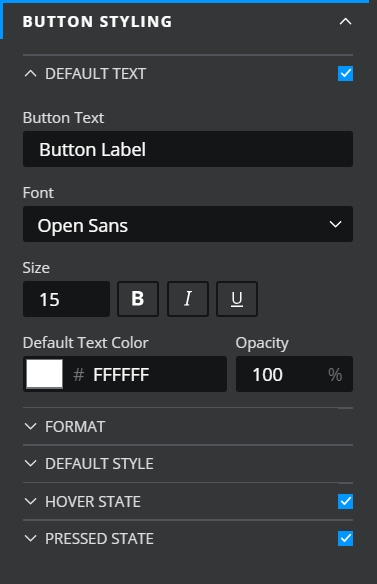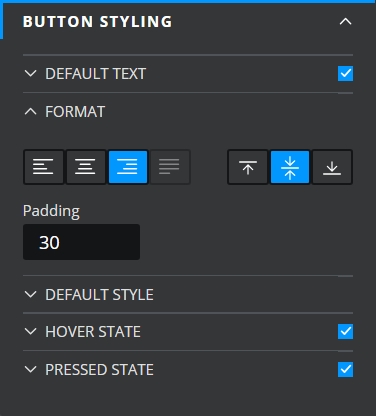Push Button
This article describes the Push Button component and its properties.
Who can use this feature?
All Squirrel365 plans include the Push Button component.
For more details, see our pricing comparison matrix.
The Push Button is used to capture mouse clicks from the user. Use it to trigger actions such as hiding or showing other components, moving data, making a selection, and so on.
Select Push Button from the Controls category of the component library. Move the mouse over the canvas and click to add a push button to your project:

Push Button Properties
The Push Button properties consist of DATA INSERTION, BUTTON STYLING, INTERACTIVITY, and DYNAMIC VISIBILITY drawers. This guide will describe the data insertion, button styling, and interactivity properties only; the dynamic visibility properties are generic to each component and a separate guide and tutorial on dynamic visibility can be found here.
DATA INSERTION
Data insertion is triggered when the push button is clicked by the user. Data insertion is one of the core concepts within Squirrel, if you aren’t sure what it is, take a look at the Getting Started: Data Insertion tutorial for more information.

Bind the Source Data property to the cell in the spreadsheet that contains the data to be copied, then bind the Destination property to a different cell that the data is to be pasted into.
BUTTON STYLING
The appearance of the button can be altered to suit a theme or particular style by using the BUTTON STYLING properties:
DEFAULT TEXT
The DEFAULT TEXT property is checked by default. Uncheck the checkbox adjacent to the DEFAULT TEXT section title to hide the default push button label.

Button Text – This property contains the text that will be shown in the push button label.
Font – Choose a font style from the dropdown list.
Size – Change the font size of the push button label.
B I U – Use these toggle buttons (bold, italic, underline) to change the format of the button label. When any of these is toggled on, the button is blue:
Default Text Color – The button label will be shown in the colour that matches the value entered in the property field.
Opacity – This determines the transparency of the button label.
FORMAT
These formatting properties apply to the default push button label.

Text alignment – Choose to align the button label to the left, right, or centre. The current selection is indicated by the blue button:
Content alignment – Choose to vertically align the button label to the top, centre or bottom of the push button component. The current selection is indicated by the blue button:
Padding – This property defines the space between the push button label and the push button border.
Individual Padding - selected this property to apply different amounts of padding to each of the component's edges. Each of these individual inputs can be manually edited or bound to the spreadsheet.
DEFAULT STYLE
In this section, you can set the color, border, and drop shadow properties of the button.

Fill – This property sets the background color of the push button. Uncheck if a fill color is not required.
Opacity – This changes the opacity of the push button.
Border – This property sets the border color of the push button.
Weight – This changes the line thickness of the push button border.
Individual Weight - selected this property to apply different widths to each of the component's borders. Each of these individual inputs can be manually edited or bound to the spreadsheet.
Line style – Select a push button border line style. The options are Solid and Dashed. (see image)

Corners – This property determines the corner radius of the push button border. Use the slider to amend this property or type a numerical value into the property field.
Individual Corners - selected this property to apply different radii to each of the component's corners. Each of these individual inputs can be manually edited or bound to the spreadsheet.
Effects – Choose between None and Drop Shadow from the dropdown box. If Drop Shadow is selected, further drop shadow properties are shown.
Color - This property sets the color of the shadow
Opacity - this property changes the opacity of the shadow
X Offset - This property adjusts the X offset of the shadow, moving it left or right depending on a positive or negative value
Y Offset - This property adjusts the Yoffset of the shadow, moving it up or down depending on a positive or negative value
Blur - This property adjusts the blur percentage of the shadow
HOVER STATE
The HOVER STATE property is checked by default. Uncheck this if you wish to disable the hover state properties.

Hover Text Color – As the mouse moves over the button, the button label text will change to the color value entered in this property field.
Opacity – As the mouse moves over the button, the opacity of the button label text will change to the value entered in this property field.
Hover Fill – As the mouse moves over the button, the button background color will change to the color value entered in this property field.
Opacity – As the mouse moves over the button, the opacity of the button will change to the value entered in this property field.
PRESSED STATE
The PRESSED STATE property is checked by default. Uncheck this if you wish to disable the pressed state properties.

Pressed Text Color – As the button is clicked, its label text will change to the color value entered in this property field.
Opacity – As the button is clicked, the opacity of its label text will change to the value entered in this property field.
Hover Fill – As the button is clicked, its background color will change to the color value entered in this property field.
Opacity – As the button is clicked, its opacity will change to the value entered in this property field.
INTERACTIVITY
It is possible to disable the push button:

Last updated
Was this helpful?